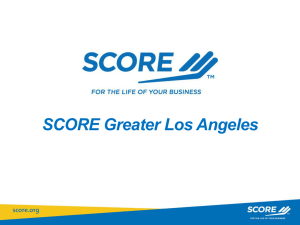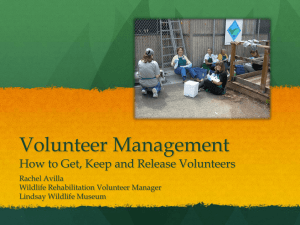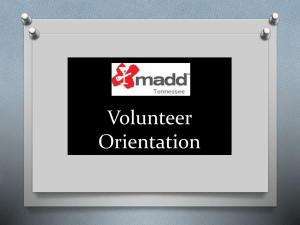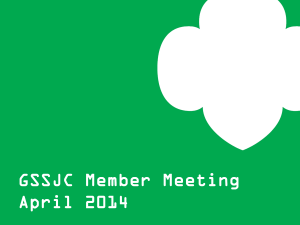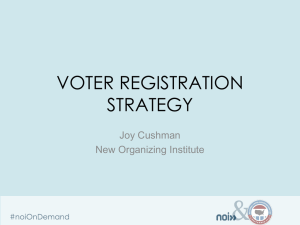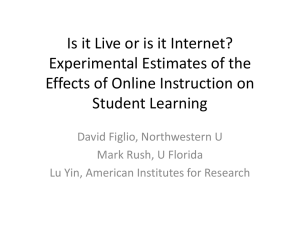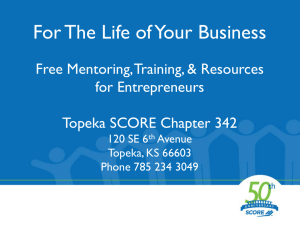Recruiting and Training Volunteers
advertisement
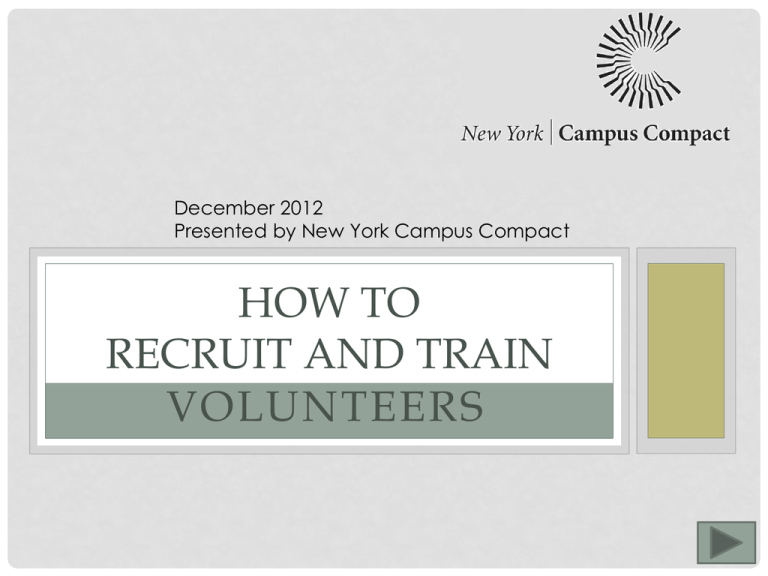
December 2012 Presented by New York Campus Compact HOW TO RECRUIT AND TRAIN VOLUNTEERS Recruiting and Training Volunteers Recruiting volunteers as an AmeriCorps VISTA is crucial to the success of your program. But, all of the volunteers in the world won’t be useful if they aren’t the right type of volunteer, aren’t appropriately trained, and aren’t apprised of important information. Recruiting Types 101 There are many ways that one can go about recruiting volunteers. But the first step is knowing type of volunteers you are seeking. According to JoAnne Fritz, Rick Lynch and Steve McCurley, authors of Essential Volunteer Management(Heritage Arts Press) suggest that there are three basic ways to recruit: Warm Body Recruitment Targeted Recruitment Concentric Circles Recruitment Let’s look at each one individually, starting with Warm Body Recruitment. When you need a large number of volunteers for a short period time and the qualifications of the task are minimal, you might engage in "warm body recruitment." This involves a broad dissemination of information, including: • Distribution of brochures • Posters • Speaking to groups • Notices in appropriate media • Word of Mouth (Fritz) Recruiting Types 102 Targeted Recruitment The targeted campaign requires a carefully planned approach to a small audience. Use this method when you are trying to recruit volunteers that need to have specific skills or not commonly found characteristics. A targeted campaign requires, at the outset, that you answer several questions: • What do we need? • Who could provide this? • How can we communicate with them? • What would motivate them? Working through such questions will help you identify and locate the volunteers that you need. Once you locate a source of such volunteers, simply take your recruitment message directly to them. (Fritz) Recruiting Types 103 Concentric Circles Recruitment This type of recruitment requires you to identify populations who are already in direct or indirect contact with your organization and then to contact them with your recruiting message. Such populations include: • Your clients, their families and relatives. • Alumni of your program/s. • Friends of your current volunteers and staff. • People in your organization's neighborhood. • People who have been affected by the problem you are attempting to solve. Concentric Circles recruitment involves people who are already familiar with your agency or the problem you address, or who are connected through friends or staff members. It is more likely that you will succeed in persuading them to volunteer than complete strangers. In sales terms, there is a big difference between a "cold" call to a stranger than a "warm" call to an acquaintance or a friend. Colder (Fritz) Warmer Recruitment Message Your Recruitment Message No matter which recruitment method you use, you must have a compelling message. Your message explains why your agency is worthy of a potential volunteer's time. Make your message short, simple, and direct, communicating the need for the volunteer's service and the good he/she can do. Stress the need of the community for the service, but also delineate the benefits the volunteer will receive. These include doing good, but there may be skills and valuable experience that the volunteer will gain. (Fritz) Other Recruiting Avenues Asking Finally, be sure to directly ask people to volunteer. The most effective way to do this is to have your staff or volunteers ask their friends and acquaintances to volunteer. Be sure to provide them with the information they need to make an effective "ask." Recruiting Volunteers Online While finding volunteers the old fashioned way through referrals and local contacts still works best, the use of online volunteer matching sites is growing, and is a way of at least doing a first quick cut of possible volunteers. Here are the some of the most widely-used volunteer matching sites: Idealist Network for Good VolunteerSolutions Volunteers of America VolunteerMatch Points of Light Be sure to check out sites that serve your particular locale as well. (Fritz) New working title The Substance Abuse and Mental Health Services Administration complied a phenomenal article concerning how to recruit and train volunteers, and they suggest using the following model. Planning -Define Your Mission - Assess Your Organization - Develop Your Volunteer Program - Describe Volunteer Positions Recruiting -Asses Your Image - Decide How to Recruit - Develop Your Message - Find Volunteers - Select Volunteers - Screen Volunteers Training Managing -Develop Orientation Program - Assign Orientation Leaders - Schedule Orientation - Develop Materials - Conduct Orientation - Train Volunteers -Assign a Supervisor - Communicate Regularly with Volunteers - Evaluate Volunteers - Avoid Volunteer Burnout - Recognize Efforts Check out the next several slides for the in-depth scoop! (“Successful Strategies”) Evaluating -Describe Your Program - Design the Evaluation - Collect Data - Analyze Data - Report Results Planning -Define Your Mission - A sound mission statement will help clarify where volunteers fit into your organization. - Assess Your Organization - Take time to understand your organization’s past history with volunteers. - Recognize what volunteers mean to your staff, and what responsibilities might be added. - Determine what work the volunteers will do, and what type of volunteers you need. - Develop Your Volunteer Program - Be sure your volunteers are supported with answers to questions, direction, and coordination. - Coordinate regular communication between the board of the organization and the volunteers - Describe Volunteer Positions - After deciding where in your program volunteers will work, you’ll need to develop position descriptions. These will help you to screen volunteers and place them in the appropriate positions. - Volunteers who understand organization expectations will be more effective and happier than those who are not oriented. (“Successful Strategies”) Recruiting -Asses Your Image - Demonstrate that your organization is worthwhile, and don’t assume everyone will know all about your programs. - Be prepared to answer questions about successes and failures, and consider showing slides to give people a better understanding of your client base - Make volunteers visible throughout the organization - Decide How to Recruit - Before choosing a specific method, consider the amount and time each one will take as well as what time you have to give. Some options include: - Network through current volunteers - Use mailings (mass, personalized, or handwritten notes) - Make announcements at services or events - ASK! - Develop Your Message - Make sure your message is inviting and encouraging! - Find Volunteers - Use your networks! Ask people to volunteer, or ask them to refer people! - Use volunteer referral services, students, and area businesses. - Select Volunteers - Determine what traits you are seeking, and hold an interview. - Be sure to thank all applicants! - Screen Volunteers - Interview, do background checks, and get to know your volunteers. - If necessary, request references - Explore the need of a contract or volunteer agreement (“Successful Strategies”) Training -Develop Orientation Program - Orientation helps your volunteers see where they fit in the entire organization - Volunteers help represent your agency to the public. You WANT them to be informed! - Assign Orientation Leaders - Determine which members of your staff are best equipped to lead orientation. - Schedule Orientation - Always set up and orient people before they begin volunteering. - Try coordinating small group orientations for teams of people. - Develop Materials - Provide each volunteer with a policy guidelines handbook with the following headings. - Background and history - Organizational Structure - Facilities - Procedures - Conduct Orientation - Give a tour of the facility, introduce staff, essentially, orient your volunteers. - Train Volunteers - Give volunteers information specific to their individual roles - Evaluate and periodically train - Remember that training and orientation are ongoing aspects. (“Successful Strategies”) Managing -Assign a Supervisor -The supervisor is responsible for making sure other people can do their job. - Make sure supervisors are people who can hold people accountable to expectations, evaluate the performance, and have regular reinforcement and recognition. - Communicate Regularly with Volunteers - Ongoing communication is essential to building positive relationships. - Check in about how the volunteer is feeling about their work and their involvement in the organization. - Evaluate Volunteers - Evaluation shows you care about your volunteers and the work that they do. - Evaluation could take the form of a trial period, performance appraisal, regular job performance meetings, review of commitments. - Evaluation gives the supervisor and the volunteer a chance to report on progress. - Avoid Volunteer Burnout - Treat volunteers with respect, they like feeling valued! - Have meaningful work for ALL volunteers. - The rule is that 20% of the volunteers are responsible for 80% of the work. Be aware of signs of burnout: anger, hostility, loss of creativity or energy, sense of purposelessness. - Recognize Efforts - Recognize volunteers in an honest and heartfelt manner - Give rewards in an ongoing basis (“Successful Strategies”) - Host regular recognition events each year. Evaluating -Describe Your Program - Develop a succinct description of your program referencing the purpose, activities, and if the program relies on volunteers. Include a needs statement, goals, resources, and what stage of development you are in. - Consider what type of evaluation would be helpful for your volunteer program as a whole. Think also about an evaluation of your orientation program. - Design the Evaluation - To design an evaluation, follow these steps: - State the purpose of the evaluation. - Define the users of the evaluation. - Define the uses of the evaluation results. - Develop evaluation questions: - Use process evaluation questions to document program implementation, such as number of people receiving services, amount of money used, funding sources, staffing and use of volunteers, and number of events. - Use outcome evaluation questions to document short-term and long-term results. - Use training evaluation questions to determine whether training is effective. Ask volunteers to rate the activities from 1 to 5. If they give a rating of less than 5, ask them how the activity could be improved. - Collect Data - Your outcomes should be relevant to the goals you are aiming to achieve. - Develop your collection instruments to ensure uniformity - Analyze Data - Be aware of factors that can influence results - Report Results - Report findings to the board - Make accommodation to your programs. (“Successful Strategies”) The Dos and Don’ts of Volunteer Recruitment So, we’ve heard about ways you can and should go about volunteer recruitment and training. Now, let’s look at some definite no-nos. Thomas W. McKee speaks of seven deadly sins you can commit to kill your project or volunteer pool. McKee has more than 40 years experience in recruiting and training volunteers, and is the owner of volunteerpower.com, a leadership firm which specializes in volunteerism. See the next slides about the seven “sins.” and read McKee’s words. Sin One: Expect Announcements to Get Volunteers We needed people in our organization to volunteer for a short-term project. I made the announcement, wrote articles in our newsletter, had people who had been involved give a fiveminute plug in several monthly meetings, and did a special mailing demonstrating the benefits for being a part of this special team. The results were very disappointing. What was wrong? What had I done wrong? I thought that the challenge would motivate leaders to get involved. I went to lunch with a person who was a mover and shaker and asked him, "Why didn't you volunteer for this project? I could see your name on it all the way." I'll never forget his response. Bill said, "If you wanted me, why didn't you ask? I'd be happy to work with you on this project, but I would never volunteer." I learned an important lesson 20 years ago that I have not forgotten. Many people will never volunteer. Why aren't people volunteering? Because people want to be asked. (McKee) Sin Two: Go It Alone One of the most effective recruiters I knew was my father. He was an Eagle Scout as a teenager. When he and Mom were first married, he was a volunteer scout leader. As I was growing up, he was always active in volunteer organizations. To meet the demands of active recruiting, Dad established a recruiting task force from the organization in which he was recruiting. His team would meet once a month with a list of vacancies. With organization directories open, they would brainstorm possible people who could fill these positions. Partnering is another effective way to recruit volunteers. Loaves and Fishes is a successful agency in Sacramento that feeds the homeless. They run the Mustard Seed School for the children of homeless families. This organization uses volunteers each day to take care of the meals and school. How do they get this many volunteers? They partner with local organizations—mostly churches. (McKee) Sin Three: Recruit Life-time Individuals —Not Short-term Project Teams Mary was asked to be on the strategic planning task force for her association. She was told that the strategic planning committee would meet for a full day for training and development of strategy. She would then have six months to work on the strategic plan and then her job would be done. Mary not only said yes, but she volunteered to work with the implementation committee of the strategic planning committee—which was another two-year commitment. Recruiting teams rather than individuals is particularly effective with younger volunteers. Many people are afraid of getting tied into a job for a lifetime and never being able to get out of it. They get burned out and then quit the organization as a way to quit their volunteer role. I accomplish three objectives when I put together a short-term project team of new volunteers with a model leader: Objective one: Volunteers are more willing to say yes to a short-term commitment with an enddate in sight. Objective two: Volunteers have the opportunity to catch the vision of the organization because they were working with a passionate leader. Objective three: Leaders became mentors for future passion driven teams. We were always looking for new leadership. (McKee) Sin Four: Assume That "No" Means "Never" Timing is everything. When we get the courage to recruit someone and then they say "no," we often feel rejection. I needed someone to be the head of our strategic planning committee and I felt that Bob was the perfect person. But when I asked him, he declined. He explained to me about a former business partner who was suing him, a teenage son who was giving him problems, and his Mercedes that was leaking oil (poor guy). He just couldn't see doing justice to the position. I asked Bob three years later and he was excited to fill the position. Sometimes the "no" means, "not now." Sometimes it means that the prospect volunteer feels that he/she would rather do something else. When the answer is "no," I often ask if there are any positions in our organization that they would love to do, but were never asked. (McKee) Sin Five: Fall Into the BIC Trap We often fall into the trap of following the BIC syndrome. Because we are in desperate need for a volunteer and need them quickly, we plead our case to anyone who "fogs a mirror" and at the last minute I get someone to be a "Butt In the Chair." Most times the chair is better empty than filled with the wrong person who does nothing or is high maintenance. (McKee) Sin Six: Be People Driven Rather Than Position Driven Another variation of the "Butt In the Chair" method is just to say, "Please come and be a part of our group. We have a great time and we need your expertise." But we don't tell the prospect what we want them to do. Joan was recruited by an after-school teen center in the inner city. She loved to do behind-thescenes work and pictured herself scrubbing floors, painting walls and stuffing envelopes. But she was placed on the finance committee at the first meeting and was asked to go out and raise money. Although she had a passion for the cause, she was overwhelmed, disappointed and quit. When I look at the volunteer team I think—"position." I ask, "What positions do I need to accomplish our mission?" "What do I want the team members to do?" And then I look for people who can fill those positions. (McKee) Sin Seven: Give the Position the Wrong Job Title What's in a name? Plenty. We are calling our professional staff by the wrong name, and it is sending the wrong message to our staff, especially when we hire them. They come to the job with the wrong credentials and the wrong expectations. By the names we use for our non-profit professional staff, we are telling them that volunteer administration is not their primary job—which it really is. We are recruiting professional staff, but not professional volunteer administrators. I see this in almost every non-profit organization. For example, most environmental association professional staff are Ph.D. biologists who are passionate about the environment. They look at themselves as environmental professionals who want to get involved in restoring wetlands. But they have to spend most of their time recruiting, motivating and training volunteers to raise money for wetland restoration. Graduate schools don't train biologists to be volunteer managers. Perhaps their sub-title should be "Manager for Environmental Services Volunteers." Tom McKee is a leading volunteer management speaker, trainer, and consultant. You can reach Tom at (916) 987-0359 or e-mail Tom@VolunteerPower.com. Other articles and free resources are available at www.volunteerpower.com. ©2012 Volunteerpower.com (McKee) Resources Fritz, Joanne. "Recruiting Volunteers - Three Approaches." About.com Nonprofit Charitable Orgs. About.Com Nonprofit Charitable Organizations, 6 Sept. 2012. Web. 15 Nov. 2012. McKee, Thomas. "The Seven Deadly Sins of Recruiting Volunteers." VolunteerPower.com. Volunteer Power, n.d. Web. 28 Oct. 2012. <http://www.volunteerpower.com/articles/7Sins.asp “Successful Strategies for Recruiting, Training, and Utilizing Volunteers: A Guide for Faith- and Community-Based Service providers: Substance Abuse and Mental Health Services Administration Faith-Based and Community Initiative." U.S. Department of Health and Human Services: Substance Abuse and Mental Health Administration: Center for Substance Abuse Treatment. 05-4005. (2005): n. page. Web. 5 Dec. 2012. <www.samhsa.gov/fbci/Volunteer_handbook.pdf>.
